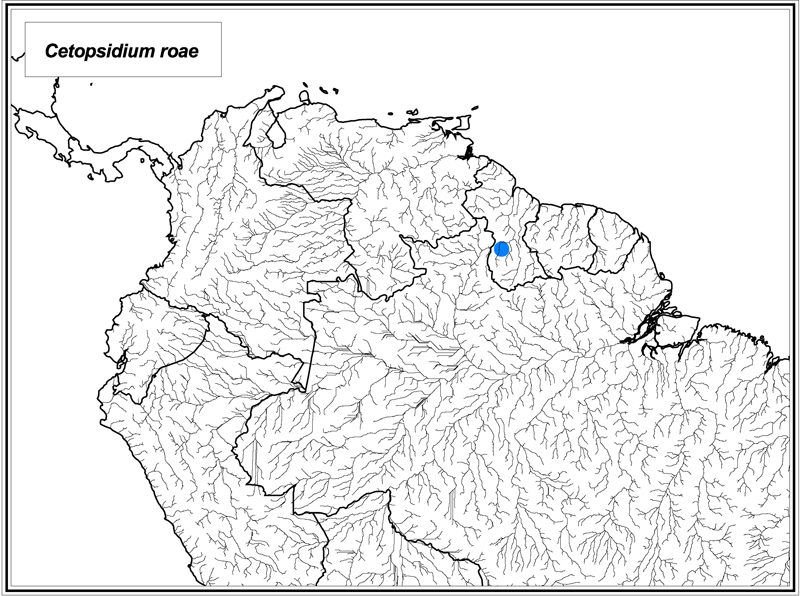
Reproduced from Vari, Ferraris and de Pinna (2005).
Cetopsidium roae Vari, Ferraris & de Pinna, 2005
Identification: Cetopsidium roae differs from all of its congeners in the position of the vent (distinctly separated from the base of the anterior most anal-fin ray versus proximate to the base of the anterior most anal-fin ray, respectively). Cetopsidium roae further differs from C. ferreirai in the alignment of the dorsal and ventral profiles of the portion of the body posterior of the base of the dorsal fin (running in parallel versus converging, respectively). Cetopsidium roae differs from C. minutum in the length of the pelvic fin (tip of the adpressed fin distinctly separated from the base of the anterior most anal-fin ray versus proximate to the base of the anterior most anal-fin ray, respectively) and in the length of the pectoral fin (tip of fin falling distinctly short of the vertical through the pelvic-fin insertion versus reaching that line, respectively). Cetopsidium roae also differs from C. morenoi in the alignment of the dorsal and ventral profiles of the portion of the body posterior of the base of the dorsal fin (running in parallel versus converging posteriorly, respectively), and in the form of the dark pigmentation on the body (small, point-like, scattered chromatophores on the dorsal and lateral surfaces of head versus large stellate chromatophores in that region, respectively). Cetopsidium roae further differs from C. orientale in the overall coloration (small, point-like, scattered chromatophores distributed over the dorsal and lateral surfaces of head and body versus large, stellate, dark chromatophores densely covering the dorsal and lateral surfaces of the head and body, respectively). Cetopsidium roae also differs from C. pemon in the alignment of the dorsal and ventral profiles of the portion of the body posterior of the base of the dorsal fin (running in parallel versus converging posteriorly, respectively) and in the prolongations of the distal portions of the first rays of the dorsal and pectoral fins in mature males as indicated by the presence of a distinctly convex margin to the anal fin (prolongations apparently absent versus present, respectively). Maximum size: 41 mm SL.
Range: Cetopsidium roae is only known from the Rupununi region of southwestern Guyana.
Information from Vari, R. P., C. J. Ferraris Jr. & M. C. C. de Pinna. 2005. The Neotropical whale catfishes (Siluriformes: Cetopsidae: Cetopsinae), a revisionary study. Neotropical Ichthyology 3:127-238.
